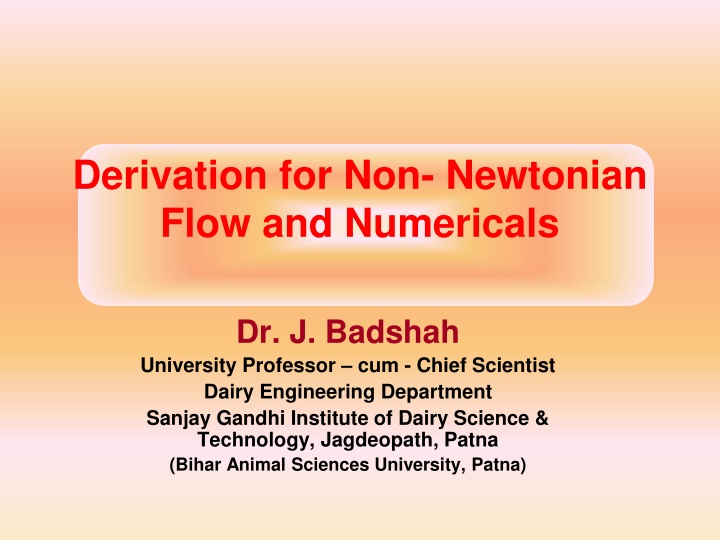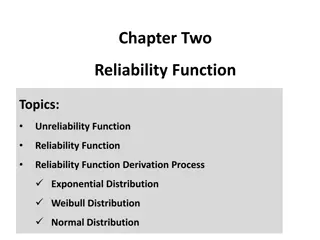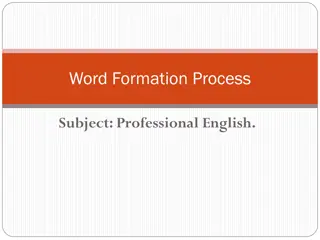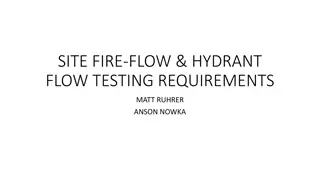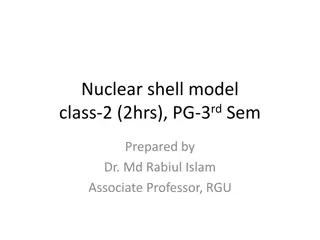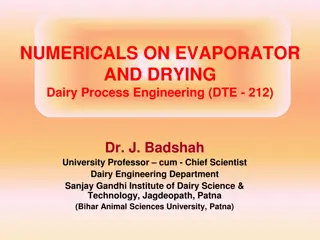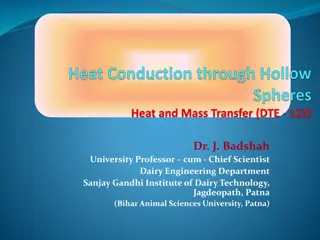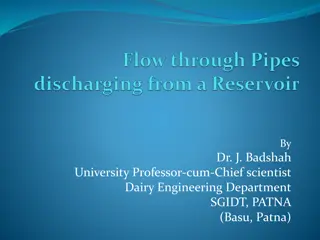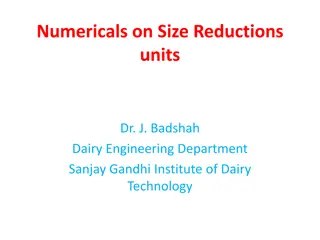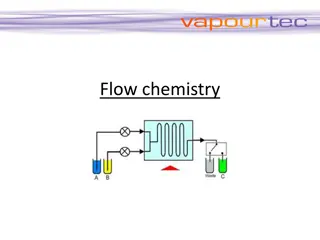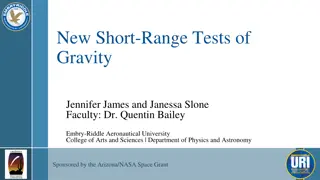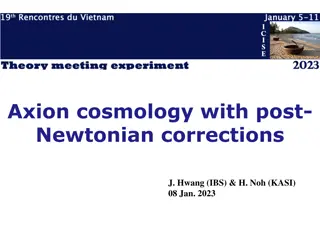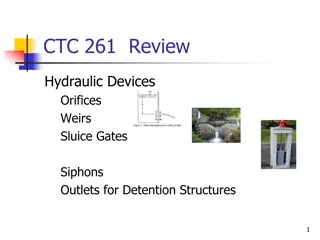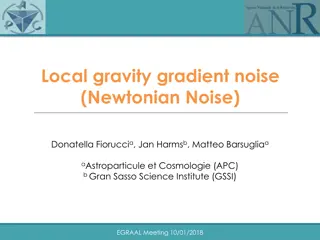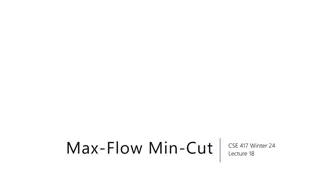Derivation for Non- Newtonian Flow and Numericals
Delve into the derivation of non-Newtonian fluid flow in a pipe, exploring the force balance, velocity profiles, and flow rate equations. Understand the influence of rheological parameters on fluid behavior through detailed derivations and numerical examples.
Download Presentation

Please find below an Image/Link to download the presentation.
The content on the website is provided AS IS for your information and personal use only. It may not be sold, licensed, or shared on other websites without obtaining consent from the author.If you encounter any issues during the download, it is possible that the publisher has removed the file from their server.
You are allowed to download the files provided on this website for personal or commercial use, subject to the condition that they are used lawfully. All files are the property of their respective owners.
The content on the website is provided AS IS for your information and personal use only. It may not be sold, licensed, or shared on other websites without obtaining consent from the author.
E N D
Presentation Transcript
Derivation for Non- Newtonian Flow and Numericals Dr. J. Badshah University Professor cum - Chief Scientist Dairy Engineering Department Sanjay Gandhi Institute of Dairy Science & Technology, Jagdeopath, Patna (Bihar Animal Sciences University, Patna)
Derivation for non-Newtonian Fluid flow in a pipe Consider the mechanism of liquid flowing through a pipe/tube by overcoming shearing resistance with a pressure difference across the cross section beween the length of pipe. Let the radius of pipe as R, diameter be D and length of shearing area of pipe is L. For an elemental ring at r from centre with a thickness dr, the ring area is 2 r dr. The shearing area of elemental ring is 2 rL and cross sectional area of element is r2.
Motion of Fluid Foods in a pipe On equilibrium at point r =r , consider the force balance on the cross section between P1and P2. The shear force for area 2 r L is equal to the force due pressure difference on the element i.e. . 2 r L = (P1 P2) r2 Therefore, = (P1 P2) .r/2L -------------------(1) Consider the fluid as non-Newtonian Therefore at radius r, = m(- dv /dr)n--------- (2) From equation 1 and 2, we have - dv = ( P/2mL)1/n. r1/ndr Integrating from r =r to r = R for velocity from vrto zero, we get Vr= ( P/2mL)1/nn/(n+1)(R(n+1)/n- r(n+1)/n) -----------(3) and average velocity vavg Vavg. R2= 2 ( P/2mL)1/nn/(n+1) r(R(n+1)/n- r(n+1)/n)dr
Derivation for Velocity profile in Newtonian flow through a pipe Therefore, vavg= ( P/2mL)1/n. n/(3n+1) R(n+1/n)------(4) This is a Rabinowitsch-Mooney equation Equation The velocity profile can be obtained from equation 3 and 4: Vr/vavg= [(3n+1)/(n+1)] [1- (r/R)(n+1)/n] -----------------(5) At r=0 , vr= Vmaxand at r = R, Keeping the values in above equation (5) for flow behavior index n =1 Vr/vavg= 2 [1- (r/R)2] and Vmax condition of laminar flow and velocity profile is completely parabolic. vr= 0 = 2 vavg, This is the
Flow Rate Equation for non- Newtonian Flow Flow Rate Q = (0 to R) Vr . 2 rdr Q = (0 to R) ( P/2mL)1/nn/(n+1)(R(n+1)/n- r(n+1)/n) . 2 rdr Q=2 ( P/2mL)1/nn/(n+1) (0 to R)[(R(n+1)/n- r(n+1)/n) . rdr] Q = ( P/2mL)1/n[n/(3n+1)]R (3n+1)/n The Rheological parameter m and n can be determined for developing model of fluids by taking log on both side. Finally draw a graph between log ( P/2L) and log Q obtained by measurement during experiment of flow through a tube viscometer. The slope of the line will be n and the intercept at certain value of log Q can determine the value of m by substituting and calculating from the final equation of log ( P/2L) versus log Q.
Flow Rate Equation for non- Newtonian Flow Log (3n+1)/n log R n log Q = n log + log( P/2mL)+ n log [n/(3n+1)]+ (3n+1) log R log( P/2mL) = - n log - n log [n/(3n+1)]- (3n+1) log R +n log Q log( P/2L) =[log m- n log - n log [n/(3n+1)]- (3n+1) log R] +n log Q It is a straight line equation if we draw a graph between log ( P/2L) and log Q. The slope will give flow behavior index n and intercept would result on calculation the consistency coefficient Determining rheological parameter, if P and Q are given. Q = log +1/n. log( P/2mL)+ log [n/(3n+1)]+ m . Solve numerical for
Maximum Shear Rates in non-Newtonian Flow through a Pipe From Equation (5), the velocity Profile forNewtonian Flow through a pipe is given as: Vr/vavg= [(3n+1)/(n+1)] [1- (r/R)(n+1)/n] -----------------(5) On Differentiating, we have dvr/dr = [(3n+1)/n] vavg[r1/n/R(n+1)/n] For maximum shear rate at the wall of pipe, r = R and we have from above equation: (dvr/dr )at r =R = [(3n+1)/n] [vavg./R] = (4 vavg) / R[3/4+1/4n] wmaximum shear rate at wall for n =1 = 4 vavg/ R and minimum shear rate at the centre of a pipe i.e. r =0, zero.
Numerical on non-Newtonian Flow A tube viscometer with0.267 cm diameter and 0.91meter length was used to obtain the following data for apple sauce product: S.No. P (105x Pa) Flow Rate Q (10- 4xm3/s) 0.91 1. 1.30 2. 1.45 2.50 3. 1.56 2.10 4. 2.00 3.20 5. 2.13 5.20 6. 2.41 8.50 7. 2.70 12.50
Numerical Solution: Draw Table for log ( P/2L) and log Q S.No. P/2Lx 105 1. 0.715 2. 0.795 3. 0.855 4. 1.095 5. 1.17 6. 1.33 7. 1.49 log Q -4.04 -3.82 -3.68 -3.50 -3.29 -3.07 -2.90 log ( P/2L) 4.85 4.90 4.93 5.04 5.07 5.12 5.17
.Contd. Draw a graph between log ( P/2L) and log Q , we have flow behaviour index n as 0.28 ( Slope of the line). The intercept is 5.15 for log Q as 3.0. Substituting in equation we have m = 4.074 Pa sn ., /dr)0.28 Experimental results with a coaxial cylinder viscometer used for banana puree at 340 K were as follows and determine the rheological parameters required to describe the product. 3. 2.0 = 4.074(- dv S.No. Shear rate (10-3x1/s) Shear stress(10- 4 x Pa) 1. 1 1.06 2. 1.5 1.22 1.37 4. 3.0 1.62 5. 4.0 1.80 6. 5.0 2.01 7. 6.0 2.10 8. 7.0 2.21
